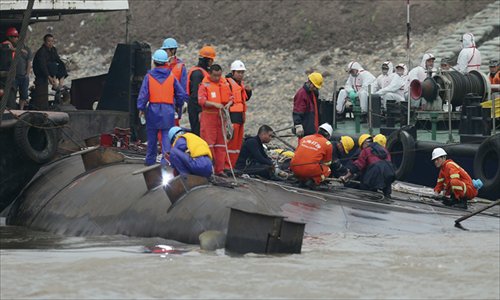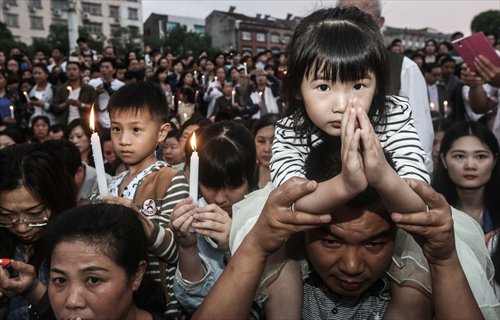Chance of survivors slim: official
77 confirmed dead as rescuers try turning ship upright

Rescue workers and the capsized ship Eastern Star are seen during a media trip to the site of the sinking, organized by the Chinese government, in the Jianli section of the Yangtze River in Hubei Province, on Thursday. Authorities pledged that there would be "no cover-up" of an investigation into the ship's sinking. Photo: CFP
Rescuers on Thursday were preparing for the worst as they started to turn the capsized cruise ship Eastern Star upright after no signs of life had been discovered from the vessel for the past two days.
The death toll from the ship jumped to 77 on Thursday from Wednesday's 29 as rescuers cut open the hull of the ship, only to find their efforts to look for more survivors were in vain.
The number of survivors remained at 14, while more than 360 people were still missing as of press time.
Xu Chengguang, a spokesperson with the Ministry of Transport, said at a press conference on Thursday night that chances of finding more survivors are fading.
"Generally speaking, there is no chance of more survivors," he said, adding that it was time to start operation to right the ship, which will speed up the search process.
On Thursday night, all but five rescue ships were ordered to leave the accident site. Rescue divers were seen wrapping the ship with steel cables earlier in the day and tying the cables to previously welded stakes.
Lin Han, an official from the Wuhan Changjiang Waterway Rescue and Salvage Bureau, told the Global Times that the ship has been stabilized and that eight stakes had been welded to prepare for the tilting procedure.
"The most important issue is how to maintain balance control. The moment the capsized ship is lifted, the center of gravity begins to shift. This could cause safety issues," said You Qinghua, a professor with the Merchant Marine College at Shanghai Maritime University.
Although some believe that the rescue can be conducted more efficiently and thoroughly if the ship is tilted upright, an expert who requested anonymity told the Global Times the fact that the ship is turned upright could also mean that the chance of finding survivors is slim and that the rescue efforts have entered a different stage.
"The water will gush in and the cabins will be disordered. This could cause further harm to the potential survivors," the expert said, adding that rescuers would not choose this plan if there were better approaches available.
With 458 people on board, Eastern Star was caught in a tornado and capsized at around 9:28 pm Monday in a section of the Yangtze River flowing through Jianli county, Hubei Province. The incident is believed to be one of China's worst maritime disasters in decades.
Until 8 pm Thursday night, rescue divers had been searching ship cabins and looking for potential survivors.
From Wednesday night to Thursday morning, rescuers cut the hull open at various locations and looked for signs of life. When the search turned futile, they welded the hull shut so the ship, floating upside down on the river, would not lose its balance.
"Cutting the hull open is our last chance to find survivors. Rescuers had previously used life detecting instruments, many times, to look for signs but found nothing. We don't want to take any chances so we decided to cut the ship open to verify," Wang Zhigang, a rescuer from the China Classification Society, a shipping and shipbuilding classification organization, told the Xinhua News Agency.
"It is an international norm that all efforts should be made to rescue life in the first 72 hours after an accident. To flip the ship over after the first 72 hours is to show respect to human life," Wang noted.

Local residents gather at Yusha Square in Jianli, Hubei Province on Thursday evening to pray for passengers on the capsized cruise ship Eastern Star. Photo: IC
On Thursday, the Standing Committee of the Political Bureau of the Communist Party of China's Central Committee met to discuss the rescue and how to handle the tragedy's aftermath. While the meeting, chaired by Chinese President Xi Jinping, called on rescuers to "take all possible measures" to save lives, it also stressed Chinese leaders' determination to thoroughly investigate the cause of the accident.
China's Ministry of Transport also promised that the investigation will be conducted with "absolutely no cover-up or concealment."
The disaster prompted hundreds of angry relatives of the victims to stage a protest near the accident site in Jianli, Hubei Province late Wednesday, demanding more information, Western media reported.
On Thursday, an official from the Ministry of Civil Affairs, Zhang Shifeng, told the media that the authorities will allow the victims' families to travel to the accident site in an organized manner to prevent rescue efforts from being interrupted.
China's Ministry of Finance allocated 10 million yuan ($1.6 million) in emergency funds for the rescue efforts.